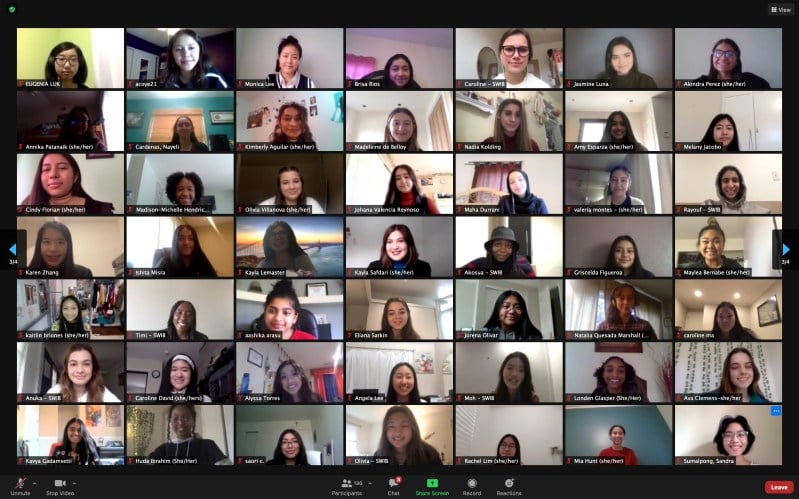At a time when most Stanford undergraduates can only connect online, several student-run organizations are taking the lead in creating communities of engaged students.
One such club, the Stanford Debate Society (SDS), is working hard to ensure its novice members have a fulfilling first year. SDS president Gaeun Kim ’22 said the club has made a large, intentional effort to form connections between its debaters over the last few quarters.
“It didn’t just come naturally to us to bond the same way or socialize in the same way that we would be able to if we were renting another person’s dorm lounge and hanging out there for a full evening,” Kim said.
Since so many of the connections between members used to form while traveling to tournaments, SDS has relied on experienced members who have “been stepping up to fill the shoes of in-person coaching and all the resources people would have easier access to if we were in person” to help create community, according to Kim.
Other clubs have also relied on older members to serve as resources for new members. Fiona Clunan ’24, an internal programming board intern for the Society for International Affairs (SIAS), said that guidance from older students has been especially important in helping new recruits develop a sense of belonging in the virtual space.
“It was great for me as a frosh who doesn’t really know many other Stanford students personally to feel welcomed by the people who run the organization,” Clunan said.
Clunan has also enjoyed the various bonding activities SIAS organized throughout the fall. She said that activities such as speed-friending and a Kahoot with facts about board members took the pressure off while still allowing club members to get to know one another.
Upperclassmen like Leland Stanford Junior University Marching Band (LSJUMB) trombone section leader Dominic DeMarco ’22 said that in some aspects, virtual programming brings forth benefits that in-person events do not have. Since last March, members of the LSJUMB have put together almost 30 new arrangements to be played once they return to campus.
“My freshman year, we looked at maybe three new arrangements, and during my sophomore year before COVID, I think there were two,” DeMarco said. “There’s been a dramatic increase, and part of that has come from COVID and the other part of that has come from [the] band’s shifting philosophy.”
While the LSJUMB had previously played songs predominantly written by white men, they’ve been working on an initiative to diversify the music they play by drawing upon artists of all genders and ethnic backgrounds, DeMarco said.
Band members also have not historically been taught how to write, arrange or compose music, but according to DeMarco, there are online workshops being planned to teach band members to arrange music. Members have also been forming groups of four to five members to virtually play and record music together, DeMarco said.
SDS has reaped similar benefits from the virtual setting. The club now works with a third coach who doesn’t live in the United States but is able to coach remotely, according to Kim.
Groups that have strong local engagement elements like the Haas Center for Public Service’s High School Support Initiative (HSSI) have been providing kinship not only for Stanford students but also for nearby high school students. The HSSI connects college students with local students for tutoring sessions.
“Typically in a classroom, you have a dynamic where students stick with their friend groups,” HSSI fellow Karim Aloul ’21 said. “When you’re tutoring, you get separated into breakout rooms, and it opens the opportunity for you and the person you’re tutoring to get to know each other.”
Tutors begin each virtual session with a new opening activity where they converse with their students, making the tutoring sessions more personal. This activity serves as a remedy to some students who do not have access to webcams, which makes sessions feel impersonal at times, according to Aloul.
“It was harder to build a direct connection without being in a shared common space,” he said.
Aava Farhadi ’23, the co-director of Stanford Women in Business’ (SWIB) Young Women’s Leadership Summit, also virtually united high schoolers, as this year’s annual summit was held online for over 230 high school students — a large increase from 150 attendees last year.
“One thing that the virtual environment allowed us to do was expand where we get our attendees from,” Farhadi said. “Usually, we have to focus on the Bay Area because students were coming to campus, so it’s not feasible for people to come from Southern California.”
Despite not being able to meet in person, Farhadi said that she and her fellow SWIB members feel closer than ever before.
“When you’re on campus, you have to purposely set aside time to meet and work through busy schedules, but now we’re able to just drop a Zoom link and people can join,” she said.
Contact Camryn Pak at cpak23 ‘at’ stanford.edu and Anuka Mohanpuhr at anuka ‘at’ stanford.edu.
